Loading and Saving Excel document in AWS S3 Cloud Storage
23 Jul 202521 minutes to read
Prerequisites
- AWS S3 Cloud Storage is required.
Loading Excel document from AWS S3
Steps to load an Excel document from AWS S3 Cloud Storage.
Step 1: Create a new ASP.NET Core Web Application (Model-View-Controller).
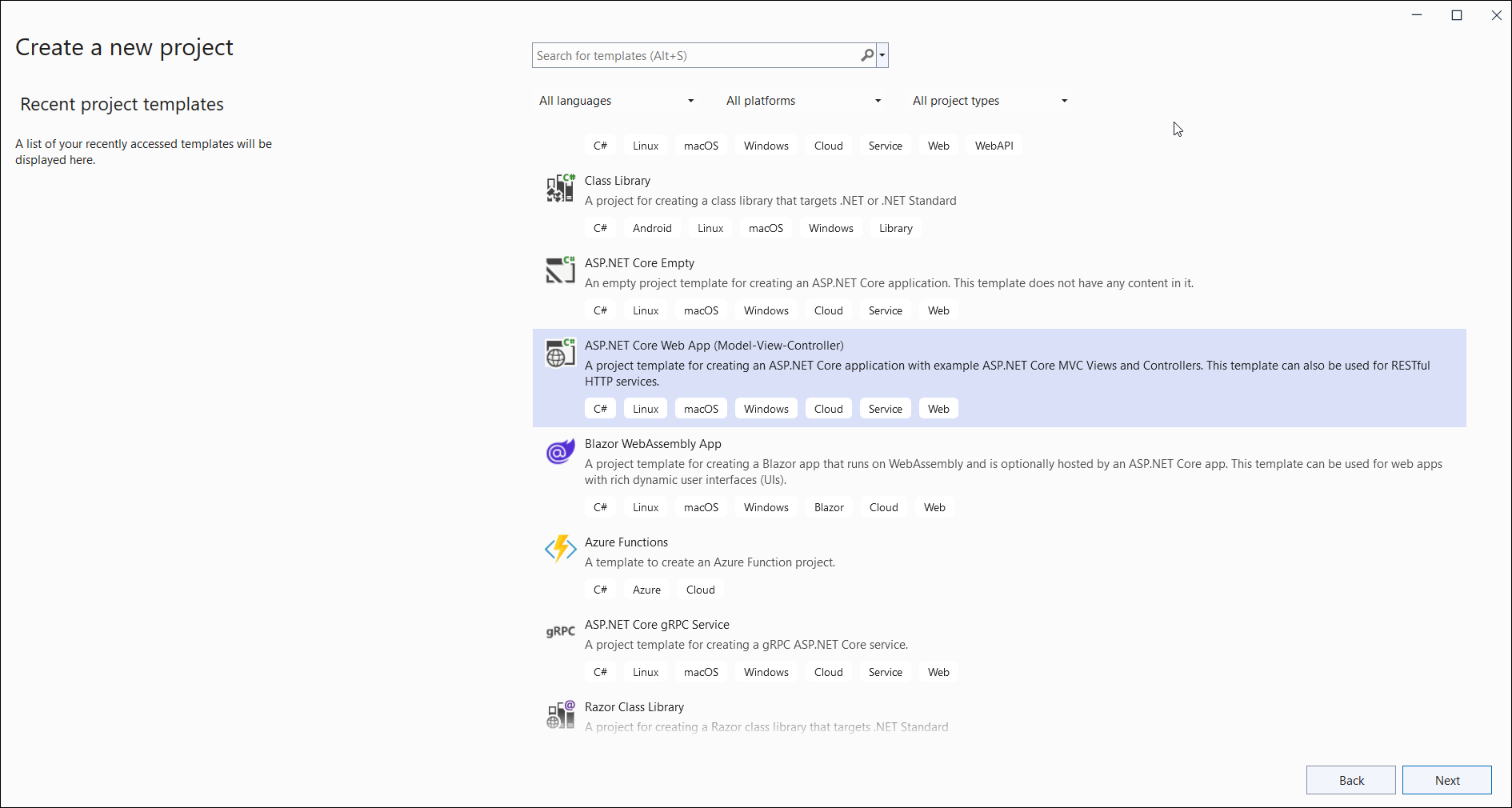
Step 2: Name the project.
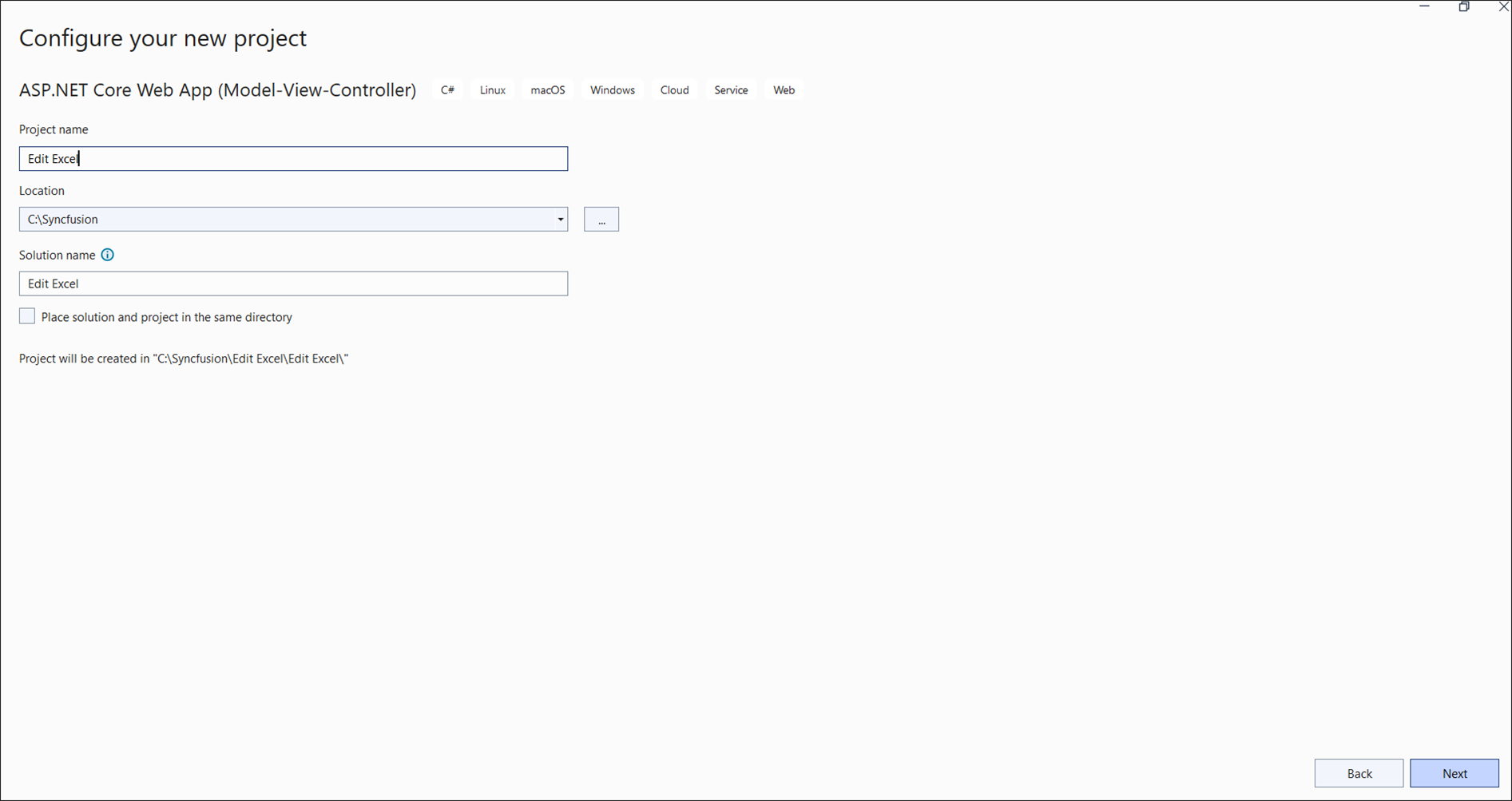
Step 3: Install the following Nuget packages in your application from NuGet.org.
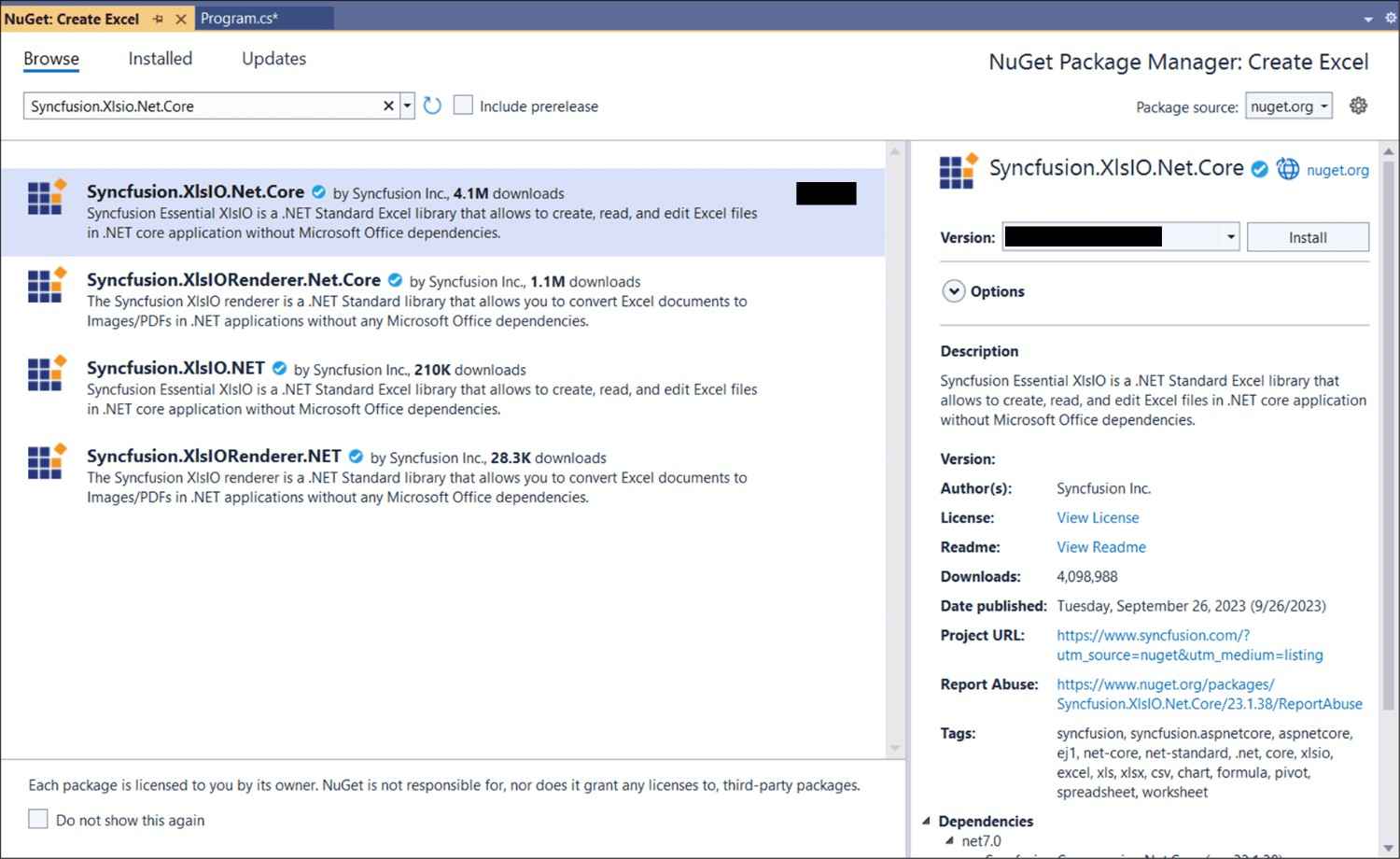
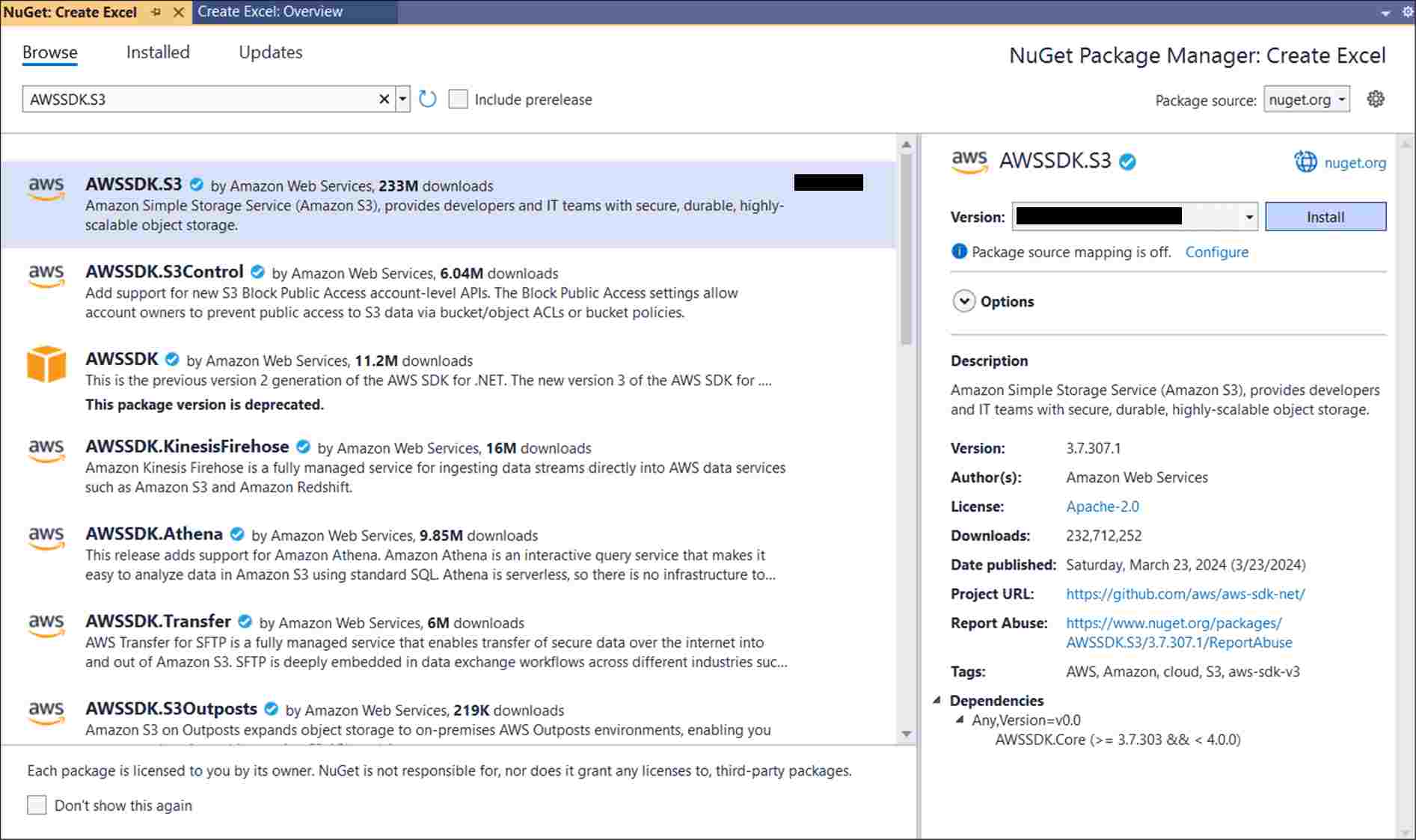
Step 4: Add a new button in the Index.cshtml as shown below.
@{Html.BeginForm("EditDocument", "Home", FormMethod.Get);
{
<div>
<input type="submit" value="Edit Document" style="width:150px;height:27px" />
</div>
}
Html.EndForm();
}Step 5: Include the following namespaces in HomeController.cs.
using Amazon;
using Amazon.S3;
using Amazon.S3.Transfer;
using Syncfusion.XlsIO;
using Syncfusion.Drawing;Step 6: Include the below code snippet in HomeController.cs to load an Excel document from AWS S3 Cloud Storage.
//Your AWS Storage Account bucket name
string bucketName = "your-bucket-name";
//Name of the Excel file you want to load from AWS S3
string key = "CreateExcel.xlsx";
// Configure AWS credentials and region
var region = Amazon.RegionEndpoint.USEast1;
var credentials = new Amazon.Runtime.BasicAWSCredentials("your-access-key", "your-secret-key");
var config = new AmazonS3Config
{
RegionEndpoint = region
};
try
{
using (var client = new AmazonS3Client(credentials, config))
{
// Create a MemoryStream to copy the file content
using (MemoryStream stream = new MemoryStream())
{
// Download the file from S3 into the MemoryStream
var response = await client.GetObjectAsync(new Amazon.S3.Model.GetObjectRequest
{
BucketName = bucketName,
Key = key
});
// Copy the response stream to the MemoryStream
await response.ResponseStream.CopyToAsync(stream);
// Set the position to the beginning of the MemoryStream
stream.Position = 0;
//Create an instance of ExcelEngine
using (ExcelEngine excelEngine = new ExcelEngine())
{
IApplication application = excelEngine.Excel;
application.DefaultVersion = ExcelVersion.Excel2016;
//Load the downloaded document
IWorkbook workbook = application.Workbooks.Open(stream);
//Access the first worksheet
IWorksheet worksheet = workbook.Worksheets[0];
//Modify the text
worksheet.Range["A3"].Text = "Hello world";
//Saving the workbook to the MemoryStream
MemoryStream outputStream = new MemoryStream();
workbook.SaveAs(outputStream);
//Set the position as '0'.
outputStream.Position = 0;
//Download the Excel file in the browser
FileStreamResult fileStreamResult = new FileStreamResult(outputStream, "application/excel");
fileStreamResult.FileDownloadName = "EditExcel.xlsx";
return fileStreamResult;
}
}
}
}
catch (Exception ex)
{
Console.WriteLine($"Error: {ex.Message}");
return Content("Error occurred while processing the file.");
}A complete working example of how to load an Excel document from AWS S3 Cloud Storage in ASP.NET Core is present on this GitHub page.
By executing the program, you will get the Excel document as follows.
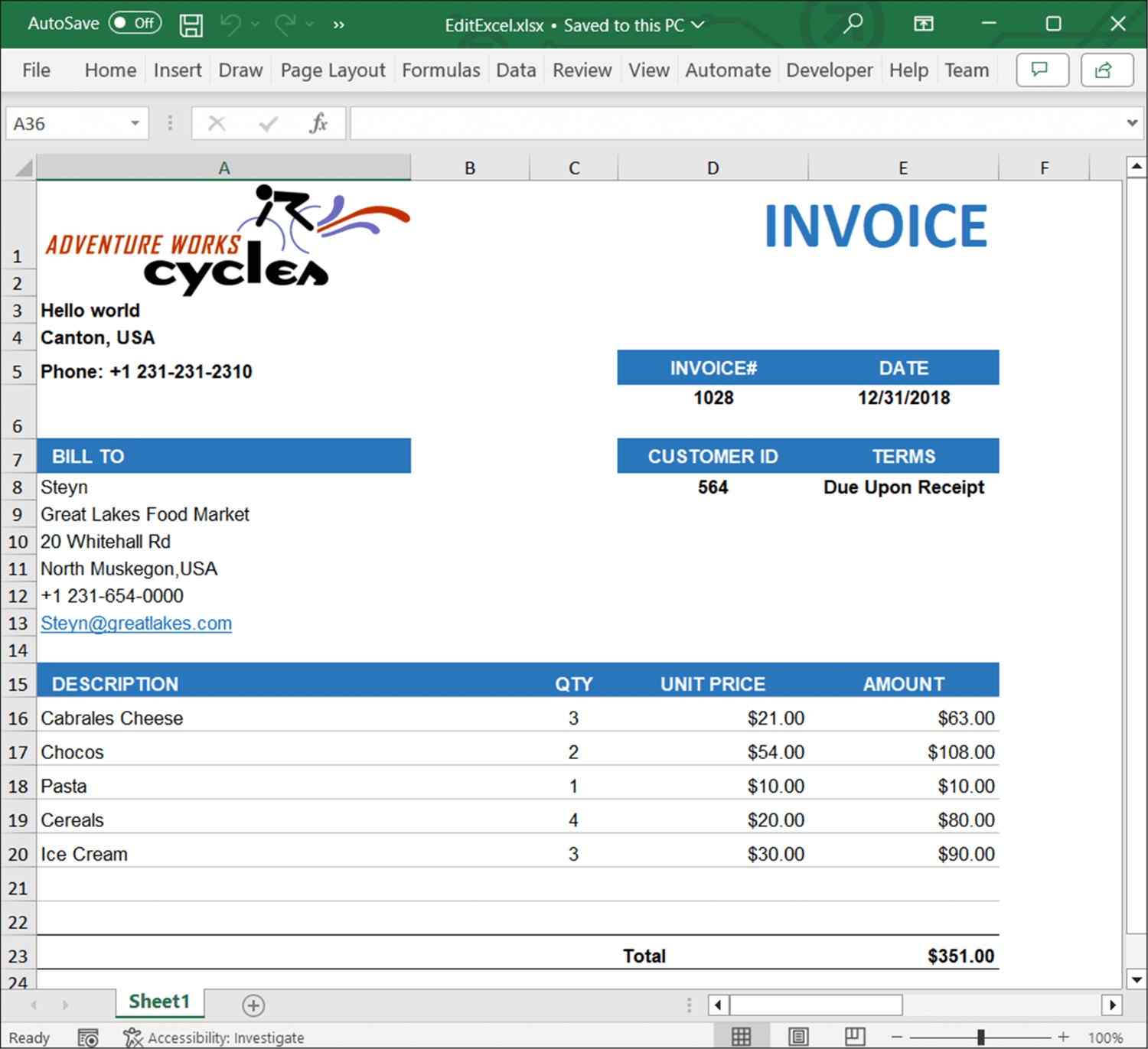
Saving Excel document to AWS S3
Steps to save an Excel document to AWS S3 Cloud Storage.
Step 1: Create a new ASP.NET Core Web Application (Model-View-Controller).

Step 2: Name the project.
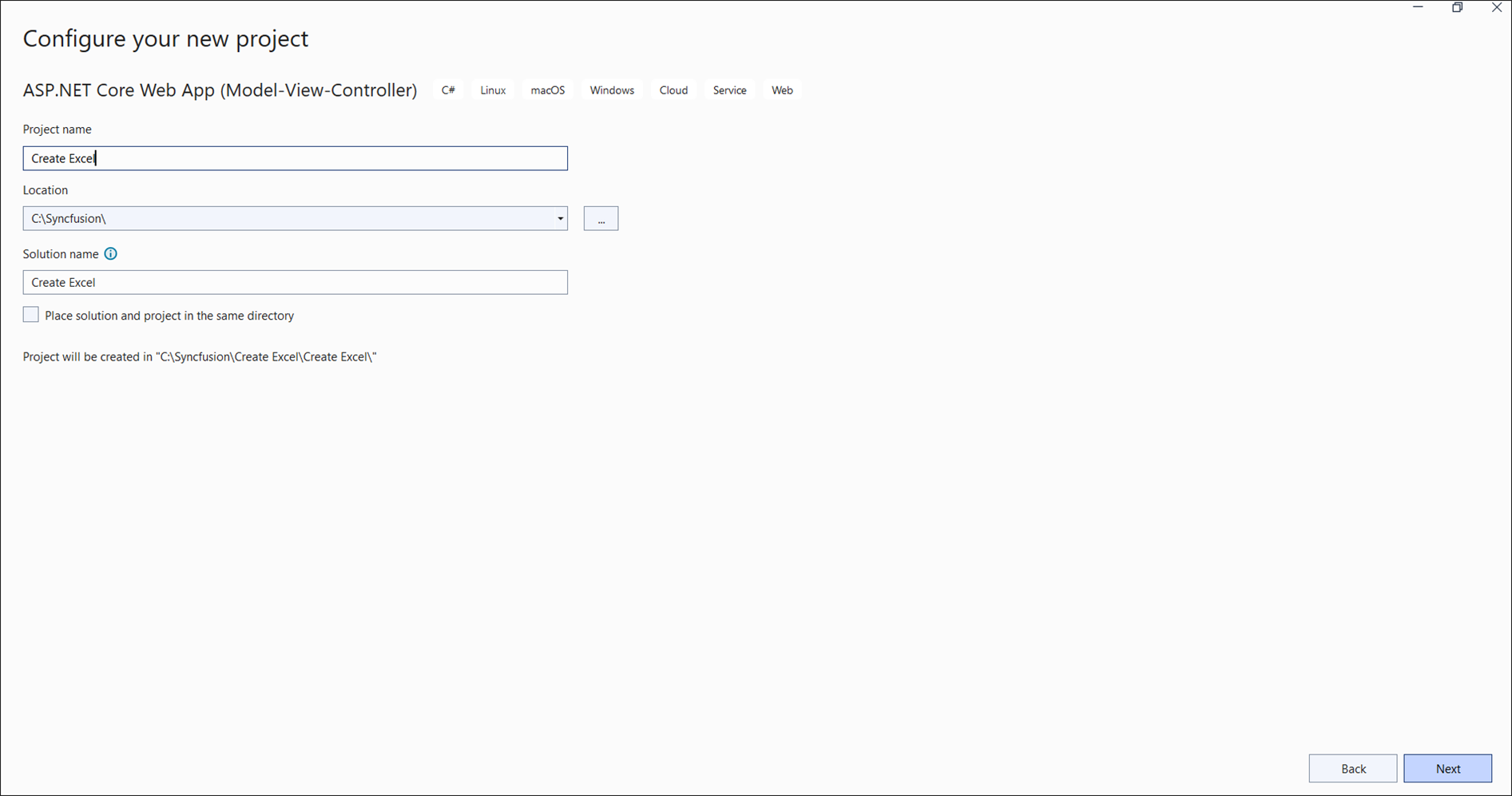
Step 3: Install the following Nuget packages in your application from NuGet.org.


Step 4: Add a new button in the Index.cshtml as shown below.
@{Html.BeginForm("CreateDocument", "Home", FormMethod.Get);
{
<div>
<input type="submit" value="Upload Document" style="width:150px;height:27px" />
</div>
}
Html.EndForm();
}Step 5: Include the following namespaces in HomeController.cs.
using Amazon;
using Amazon.S3;
using Amazon.S3.Transfer;
using Syncfusion.XlsIO;
using Syncfusion.Drawing;Step 6: Include the below code snippet in HomeController.cs to Save an Excel document to AWS S3 Storage.
//Create an instance of ExcelEngine
using (ExcelEngine excelEngine = new ExcelEngine())
{
IApplication application = excelEngine.Excel;
application.DefaultVersion = ExcelVersion.Xlsx;
//Create a workbook
IWorkbook workbook = application.Workbooks.Create(1);
IWorksheet worksheet = workbook.Worksheets[0];
//Adding a picture
FileStream imageStream = new FileStream("AdventureCycles-Logo.png", FileMode.Open, FileAccess.Read);
IPictureShape shape = worksheet.Pictures.AddPicture(1, 1, imageStream, 20, 20);
//Disable gridlines in the worksheet
worksheet.IsGridLinesVisible = false;
//Enter values to the cells from A3 to A5
worksheet.Range["A3"].Text = "46036 Michigan Ave";
worksheet.Range["A4"].Text = "Canton, USA";
worksheet.Range["A5"].Text = "Phone: +1 231-231-2310";
//Make the text bold
worksheet.Range["A3:A5"].CellStyle.Font.Bold = true;
//Merge cells
worksheet.Range["D1:E1"].Merge();
//Enter text to the cell D1 and apply formatting.
worksheet.Range["D1"].Text = "INVOICE";
worksheet.Range["D1"].CellStyle.Font.Bold = true;
worksheet.Range["D1"].CellStyle.Font.RGBColor = Color.FromArgb(42, 118, 189);
worksheet.Range["D1"].CellStyle.Font.Size = 35;
//Apply alignment in the cell D1
worksheet.Range["D1"].CellStyle.HorizontalAlignment = ExcelHAlign.HAlignRight;
worksheet.Range["D1"].CellStyle.VerticalAlignment = ExcelVAlign.VAlignTop;
//Enter values to the cells from D5 to E8
worksheet.Range["D5"].Text = "INVOICE#";
worksheet.Range["E5"].Text = "DATE";
worksheet.Range["D6"].Number = 1028;
worksheet.SetValue(6, 5, "12/31/2018");
worksheet.Range["D7"].Text = "CUSTOMER ID";
worksheet.Range["E7"].Text = "TERMS";
worksheet.Range["D8"].Number = 564;
worksheet.Range["E8"].Text = "Due Upon Receipt";
//Apply RGB backcolor to the cells from D5 to E8
worksheet.Range["D5:E5"].CellStyle.Color = Color.FromArgb(42, 118, 189);
worksheet.Range["D7:E7"].CellStyle.Color = Color.FromArgb(42, 118, 189);
//Apply known colors to the text in cells D5 to E8
worksheet.Range["D5:E5"].CellStyle.Font.Color = ExcelKnownColors.White;
worksheet.Range["D7:E7"].CellStyle.Font.Color = ExcelKnownColors.White;
//Make the text as bold from D5 to E8
worksheet.Range["D5:E8"].CellStyle.Font.Bold = true;
//Apply alignment to the cells from D5 to E8
worksheet.Range["D5:E8"].CellStyle.HorizontalAlignment = ExcelHAlign.HAlignCenter;
worksheet.Range["D5:E5"].CellStyle.VerticalAlignment = ExcelVAlign.VAlignCenter;
worksheet.Range["D7:E7"].CellStyle.VerticalAlignment = ExcelVAlign.VAlignCenter;
worksheet.Range["D6:E6"].CellStyle.VerticalAlignment = ExcelVAlign.VAlignTop;
//Enter value and applying formatting in the cell A7
worksheet.Range["A7"].Text = " BILL TO";
worksheet.Range["A7"].CellStyle.Color = Color.FromArgb(42, 118, 189);
worksheet.Range["A7"].CellStyle.Font.Bold = true;
worksheet.Range["A7"].CellStyle.Font.Color = ExcelKnownColors.White;
//Apply alignment
worksheet.Range["A7"].CellStyle.HorizontalAlignment = ExcelHAlign.HAlignLeft;
worksheet.Range["A7"].CellStyle.VerticalAlignment = ExcelVAlign.VAlignCenter;
//Enter values in the cells A8 to A12
worksheet.Range["A8"].Text = "Steyn";
worksheet.Range["A9"].Text = "Great Lakes Food Market";
worksheet.Range["A10"].Text = "20 Whitehall Rd";
worksheet.Range["A11"].Text = "North Muskegon,USA";
worksheet.Range["A12"].Text = "+1 231-654-0000";
//Create a Hyperlink for e-mail in the cell A13
IHyperLink hyperlink = worksheet.HyperLinks.Add(worksheet.Range["A13"]);
hyperlink.Type = ExcelHyperLinkType.Url;
hyperlink.Address = "[email protected]";
hyperlink.ScreenTip = "Send Mail";
//Merge column A and B from row 15 to 22
worksheet.Range["A15:B15"].Merge();
worksheet.Range["A16:B16"].Merge();
worksheet.Range["A17:B17"].Merge();
worksheet.Range["A18:B18"].Merge();
worksheet.Range["A19:B19"].Merge();
worksheet.Range["A20:B20"].Merge();
worksheet.Range["A21:B21"].Merge();
worksheet.Range["A22:B22"].Merge();
//Enter details of products and prices
worksheet.Range["A15"].Text = " DESCRIPTION";
worksheet.Range["C15"].Text = "QTY";
worksheet.Range["D15"].Text = "UNIT PRICE";
worksheet.Range["E15"].Text = "AMOUNT";
worksheet.Range["A16"].Text = "Cabrales Cheese";
worksheet.Range["A17"].Text = "Chocos";
worksheet.Range["A18"].Text = "Pasta";
worksheet.Range["A19"].Text = "Cereals";
worksheet.Range["A20"].Text = "Ice Cream";
worksheet.Range["C16"].Number = 3;
worksheet.Range["C17"].Number = 2;
worksheet.Range["C18"].Number = 1;
worksheet.Range["C19"].Number = 4;
worksheet.Range["C20"].Number = 3;
worksheet.Range["D16"].Number = 21;
worksheet.Range["D17"].Number = 54;
worksheet.Range["D18"].Number = 10;
worksheet.Range["D19"].Number = 20;
worksheet.Range["D20"].Number = 30;
worksheet.Range["D23"].Text = "Total";
//Apply number format
worksheet.Range["D16:E22"].NumberFormat = "$.00";
worksheet.Range["E23"].NumberFormat = "$.00";
//Apply incremental formula for column Amount by multiplying Qty and UnitPrice
application.EnableIncrementalFormula = true;
worksheet.Range["E16:E20"].Formula = "=C16*D16";
//Formula for Sum the total
worksheet.Range["E23"].Formula = "=SUM(E16:E22)";
//Apply borders
worksheet.Range["A16:E22"].CellStyle.Borders[ExcelBordersIndex.EdgeTop].LineStyle = ExcelLineStyle.Thin;
worksheet.Range["A16:E22"].CellStyle.Borders[ExcelBordersIndex.EdgeBottom].LineStyle = ExcelLineStyle.Thin;
worksheet.Range["A16:E22"].CellStyle.Borders[ExcelBordersIndex.EdgeTop].Color = ExcelKnownColors.Grey_25_percent;
worksheet.Range["A16:E22"].CellStyle.Borders[ExcelBordersIndex.EdgeBottom].Color = ExcelKnownColors.Grey_25_percent;
worksheet.Range["A23:E23"].CellStyle.Borders[ExcelBordersIndex.EdgeTop].LineStyle = ExcelLineStyle.Thin;
worksheet.Range["A23:E23"].CellStyle.Borders[ExcelBordersIndex.EdgeBottom].LineStyle = ExcelLineStyle.Thin;
worksheet.Range["A23:E23"].CellStyle.Borders[ExcelBordersIndex.EdgeTop].Color = ExcelKnownColors.Black;
worksheet.Range["A23:E23"].CellStyle.Borders[ExcelBordersIndex.EdgeBottom].Color = ExcelKnownColors.Black;
//Apply font setting for cells with product details
worksheet.Range["A3:E23"].CellStyle.Font.FontName = "Arial";
worksheet.Range["A3:E23"].CellStyle.Font.Size = 10;
worksheet.Range["A15:E15"].CellStyle.Font.Color = ExcelKnownColors.White;
worksheet.Range["A15:E15"].CellStyle.Font.Bold = true;
worksheet.Range["D23:E23"].CellStyle.Font.Bold = true;
//Apply cell color
worksheet.Range["A15:E15"].CellStyle.Color = Color.FromArgb(42, 118, 189);
//Apply alignment to cells with product details
worksheet.Range["A15"].CellStyle.HorizontalAlignment = ExcelHAlign.HAlignLeft;
worksheet.Range["C15:C22"].CellStyle.HorizontalAlignment = ExcelHAlign.HAlignCenter;
worksheet.Range["D15:E15"].CellStyle.HorizontalAlignment = ExcelHAlign.HAlignCenter;
//Apply row height and column width to look good
worksheet.Range["A1"].ColumnWidth = 36;
worksheet.Range["B1"].ColumnWidth = 11;
worksheet.Range["C1"].ColumnWidth = 8;
worksheet.Range["D1:E1"].ColumnWidth = 18;
worksheet.Range["A1"].RowHeight = 47;
worksheet.Range["A2"].RowHeight = 15;
worksheet.Range["A3:A4"].RowHeight = 15;
worksheet.Range["A5"].RowHeight = 18;
worksheet.Range["A6"].RowHeight = 29;
worksheet.Range["A7"].RowHeight = 18;
worksheet.Range["A8"].RowHeight = 15;
worksheet.Range["A9:A14"].RowHeight = 15;
worksheet.Range["A15:A23"].RowHeight = 18;
//Saving the Excel to the MemoryStream
MemoryStream stream = new MemoryStream();
workbook.SaveAs(stream);
//Set the position as '0'.
stream.Position = 0;
//Your AWS Storage Account bucket name
string bucketName = "your-bucket-name";
//Name of the Excel file you want to upload
string keyName = "CreateExcel.xlsx";
// Configure AWS credentials and region
var region = RegionEndpoint.USEast1;
var credentials = new Amazon.Runtime.BasicAWSCredentials("your-access-key", "your-secret-key");
var config = new AmazonS3Config
{
RegionEndpoint = region
};
using (var client = new AmazonS3Client(credentials, config))
{
var fileTransferUtility = new TransferUtility(client);
try
{
// Upload the stream to AWS S3
await fileTransferUtility.UploadAsync(stream, bucketName, keyName);
Console.WriteLine("Upload completed successfully");
}
catch (AmazonS3Exception e)
{
Console.WriteLine("Error encountered on server. Message:'{0}' when writing an object", e.Message);
}
catch (Exception e)
{
Console.WriteLine("Unknown encountered on server. Message:'{0}' when writing an object", e.Message);
}
}
return Ok("Excel document uploaded to AWS S3 Storage.");
}A complete working example of how to save an Excel document to AWS S3 Cloud Storage in ASP.NET Core is present on this GitHub page.
By executing the program, you will get the Excel document as follows.
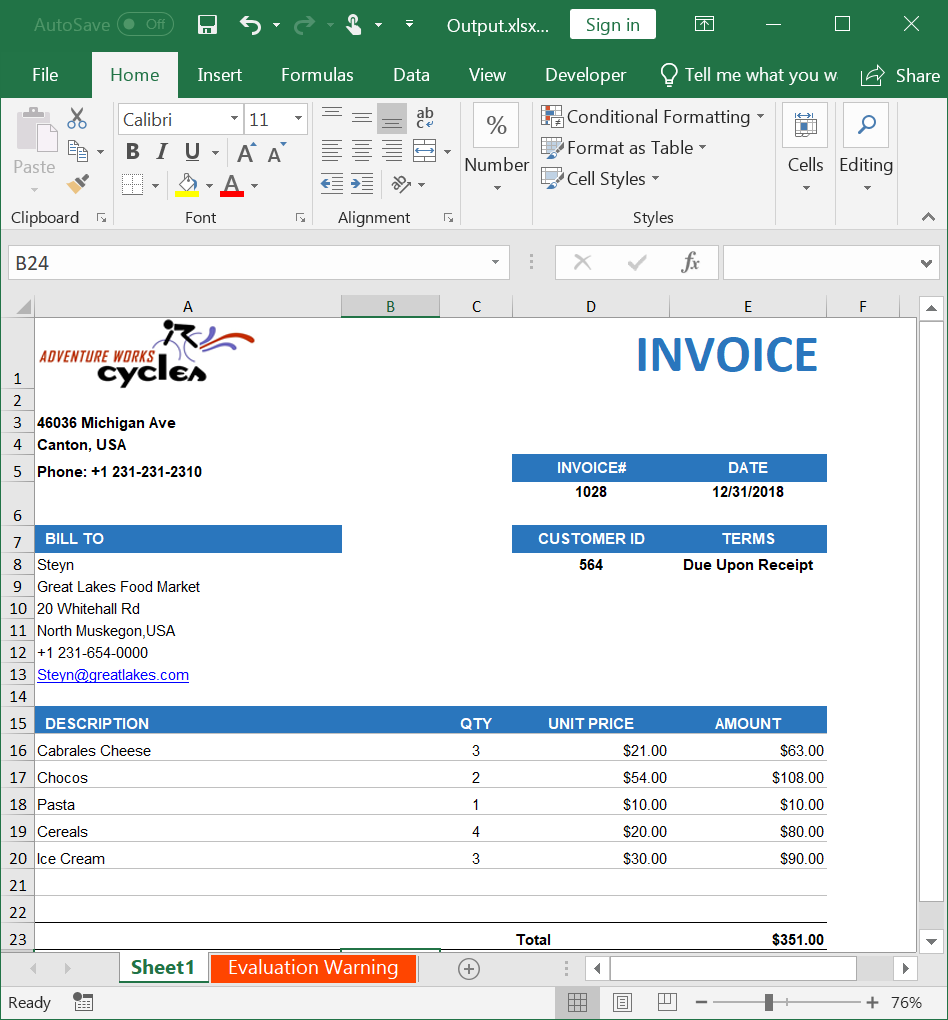
Click here to explore the rich set of Syncfusion® Excel library (XlsIO) features.
An online sample link to create an Excel document in ASP.NET Core.